Analyzing the Importance of Culture in International Marketing
VerifiedAdded on 2023/06/11
|8
|1645
|182
Essay
AI Summary
This essay discusses the critical role of culture in international marketing, emphasizing the need for businesses to understand and adapt to different cultural norms and social behaviors. It highlights the relevance of Dr. Geert Hofstede's cultural dimensions model and Dave Chaff’s 7P model in shaping effective marketing strategies. The essay explores how cultural dimensions such as power distance, individualism, masculinity, uncertainty avoidance, and pragmatism influence marketing approaches. It also examines the 4Ps (Product, Price, Place, Promotion) and 7Ps (adding Physical Evidence, People, and Partners) in the context of international markets, using examples like Nike and Coke to illustrate successful cultural adaptation. The essay concludes that integrating cultural understanding into marketing campaigns is essential for achieving competitive advantage and consumer satisfaction in the global market.
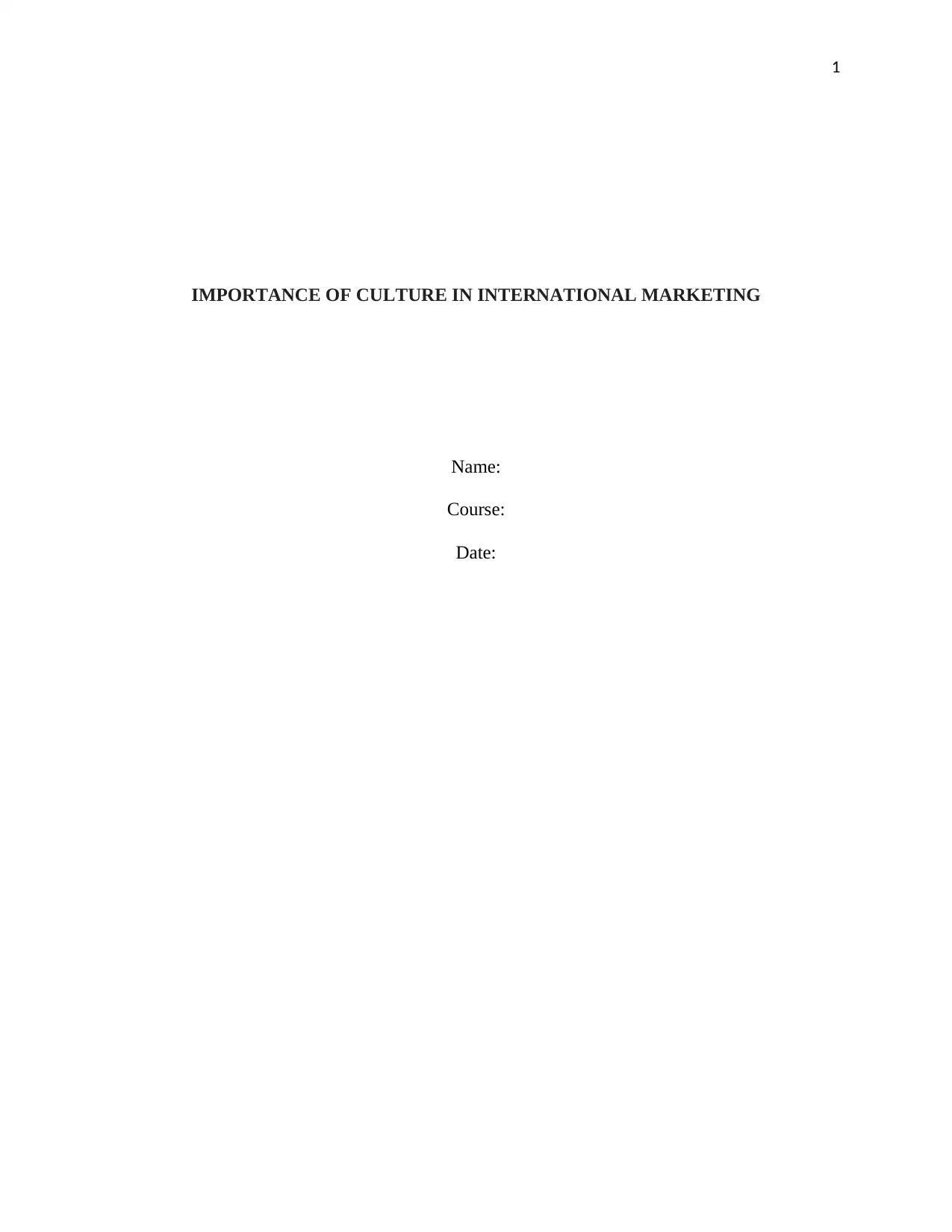
1
IMPORTANCE OF CULTURE IN INTERNATIONAL MARKETING
Name:
Course:
Date:
IMPORTANCE OF CULTURE IN INTERNATIONAL MARKETING
Name:
Course:
Date:
Paraphrase This Document
Need a fresh take? Get an instant paraphrase of this document with our AI Paraphraser
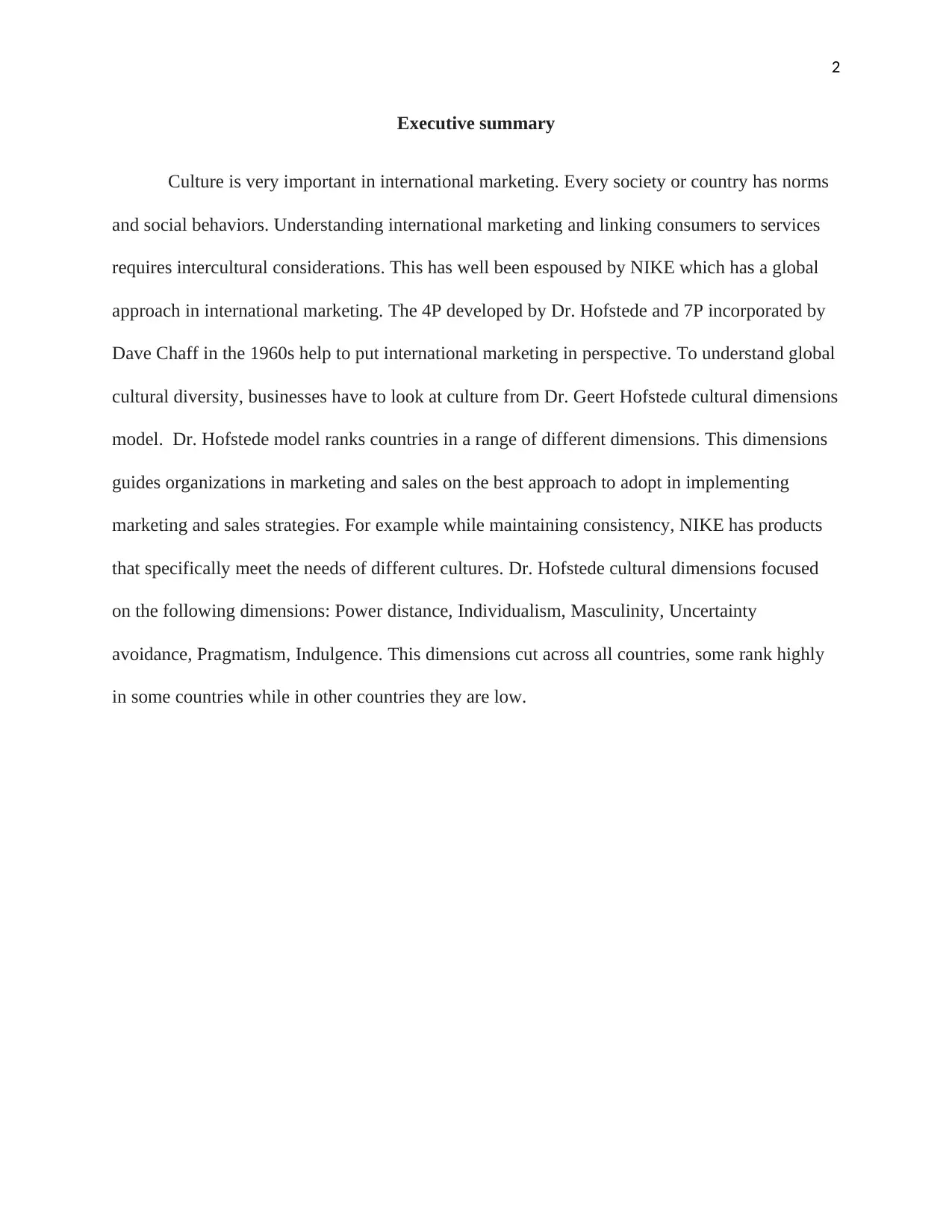
2
Executive summary
Culture is very important in international marketing. Every society or country has norms
and social behaviors. Understanding international marketing and linking consumers to services
requires intercultural considerations. This has well been espoused by NIKE which has a global
approach in international marketing. The 4P developed by Dr. Hofstede and 7P incorporated by
Dave Chaff in the 1960s help to put international marketing in perspective. To understand global
cultural diversity, businesses have to look at culture from Dr. Geert Hofstede cultural dimensions
model. Dr. Hofstede model ranks countries in a range of different dimensions. This dimensions
guides organizations in marketing and sales on the best approach to adopt in implementing
marketing and sales strategies. For example while maintaining consistency, NIKE has products
that specifically meet the needs of different cultures. Dr. Hofstede cultural dimensions focused
on the following dimensions: Power distance, Individualism, Masculinity, Uncertainty
avoidance, Pragmatism, Indulgence. This dimensions cut across all countries, some rank highly
in some countries while in other countries they are low.
Executive summary
Culture is very important in international marketing. Every society or country has norms
and social behaviors. Understanding international marketing and linking consumers to services
requires intercultural considerations. This has well been espoused by NIKE which has a global
approach in international marketing. The 4P developed by Dr. Hofstede and 7P incorporated by
Dave Chaff in the 1960s help to put international marketing in perspective. To understand global
cultural diversity, businesses have to look at culture from Dr. Geert Hofstede cultural dimensions
model. Dr. Hofstede model ranks countries in a range of different dimensions. This dimensions
guides organizations in marketing and sales on the best approach to adopt in implementing
marketing and sales strategies. For example while maintaining consistency, NIKE has products
that specifically meet the needs of different cultures. Dr. Hofstede cultural dimensions focused
on the following dimensions: Power distance, Individualism, Masculinity, Uncertainty
avoidance, Pragmatism, Indulgence. This dimensions cut across all countries, some rank highly
in some countries while in other countries they are low.
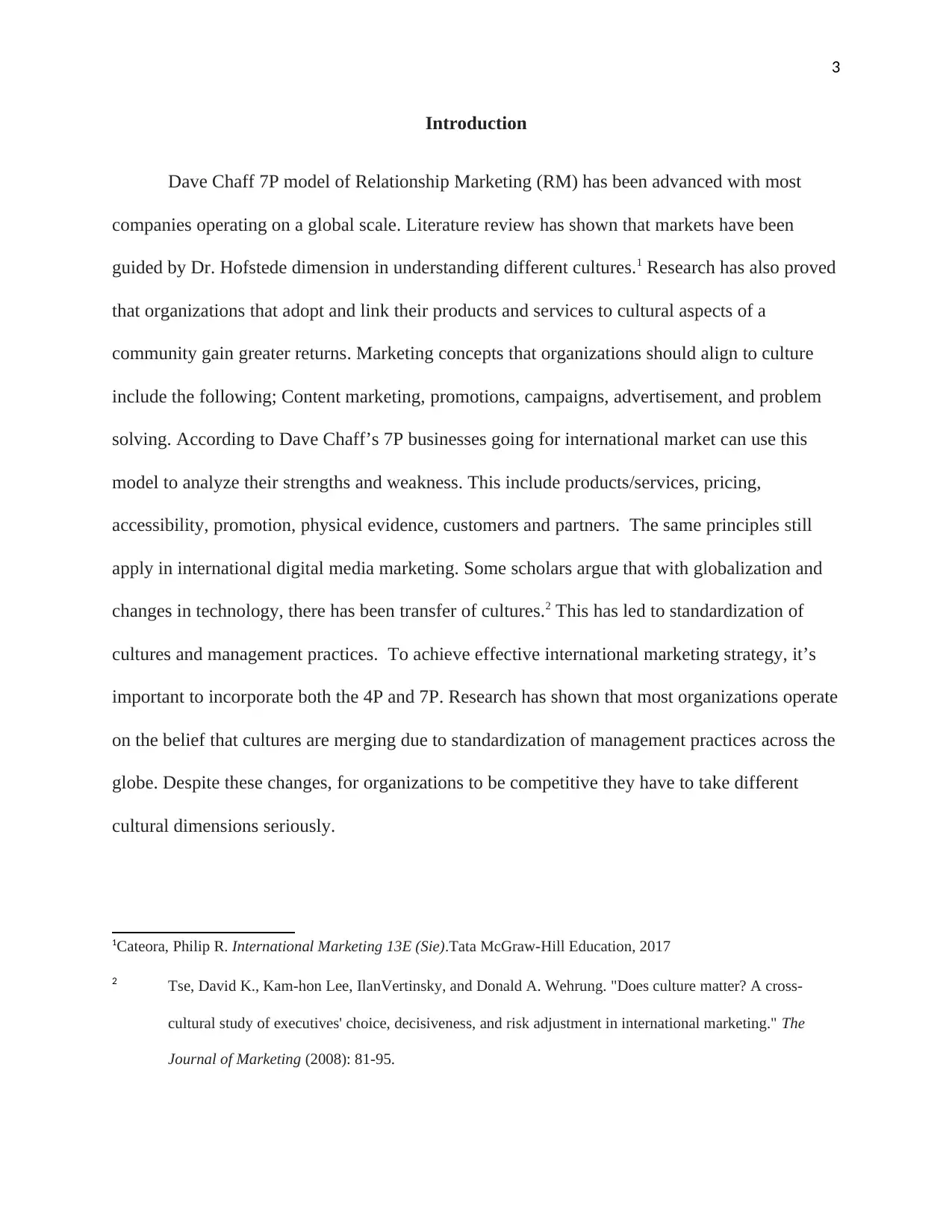
3
Introduction
Dave Chaff 7P model of Relationship Marketing (RM) has been advanced with most
companies operating on a global scale. Literature review has shown that markets have been
guided by Dr. Hofstede dimension in understanding different cultures.1 Research has also proved
that organizations that adopt and link their products and services to cultural aspects of a
community gain greater returns. Marketing concepts that organizations should align to culture
include the following; Content marketing, promotions, campaigns, advertisement, and problem
solving. According to Dave Chaff’s 7P businesses going for international market can use this
model to analyze their strengths and weakness. This include products/services, pricing,
accessibility, promotion, physical evidence, customers and partners. The same principles still
apply in international digital media marketing. Some scholars argue that with globalization and
changes in technology, there has been transfer of cultures.2 This has led to standardization of
cultures and management practices. To achieve effective international marketing strategy, it’s
important to incorporate both the 4P and 7P. Research has shown that most organizations operate
on the belief that cultures are merging due to standardization of management practices across the
globe. Despite these changes, for organizations to be competitive they have to take different
cultural dimensions seriously.
1Cateora, Philip R. International Marketing 13E (Sie).Tata McGraw-Hill Education, 2017
2 Tse, David K., Kam-hon Lee, IlanVertinsky, and Donald A. Wehrung. "Does culture matter? A cross-
cultural study of executives' choice, decisiveness, and risk adjustment in international marketing." The
Journal of Marketing (2008): 81-95.
Introduction
Dave Chaff 7P model of Relationship Marketing (RM) has been advanced with most
companies operating on a global scale. Literature review has shown that markets have been
guided by Dr. Hofstede dimension in understanding different cultures.1 Research has also proved
that organizations that adopt and link their products and services to cultural aspects of a
community gain greater returns. Marketing concepts that organizations should align to culture
include the following; Content marketing, promotions, campaigns, advertisement, and problem
solving. According to Dave Chaff’s 7P businesses going for international market can use this
model to analyze their strengths and weakness. This include products/services, pricing,
accessibility, promotion, physical evidence, customers and partners. The same principles still
apply in international digital media marketing. Some scholars argue that with globalization and
changes in technology, there has been transfer of cultures.2 This has led to standardization of
cultures and management practices. To achieve effective international marketing strategy, it’s
important to incorporate both the 4P and 7P. Research has shown that most organizations operate
on the belief that cultures are merging due to standardization of management practices across the
globe. Despite these changes, for organizations to be competitive they have to take different
cultural dimensions seriously.
1Cateora, Philip R. International Marketing 13E (Sie).Tata McGraw-Hill Education, 2017
2 Tse, David K., Kam-hon Lee, IlanVertinsky, and Donald A. Wehrung. "Does culture matter? A cross-
cultural study of executives' choice, decisiveness, and risk adjustment in international marketing." The
Journal of Marketing (2008): 81-95.
⊘ This is a preview!⊘
Do you want full access?
Subscribe today to unlock all pages.

Trusted by 1+ million students worldwide
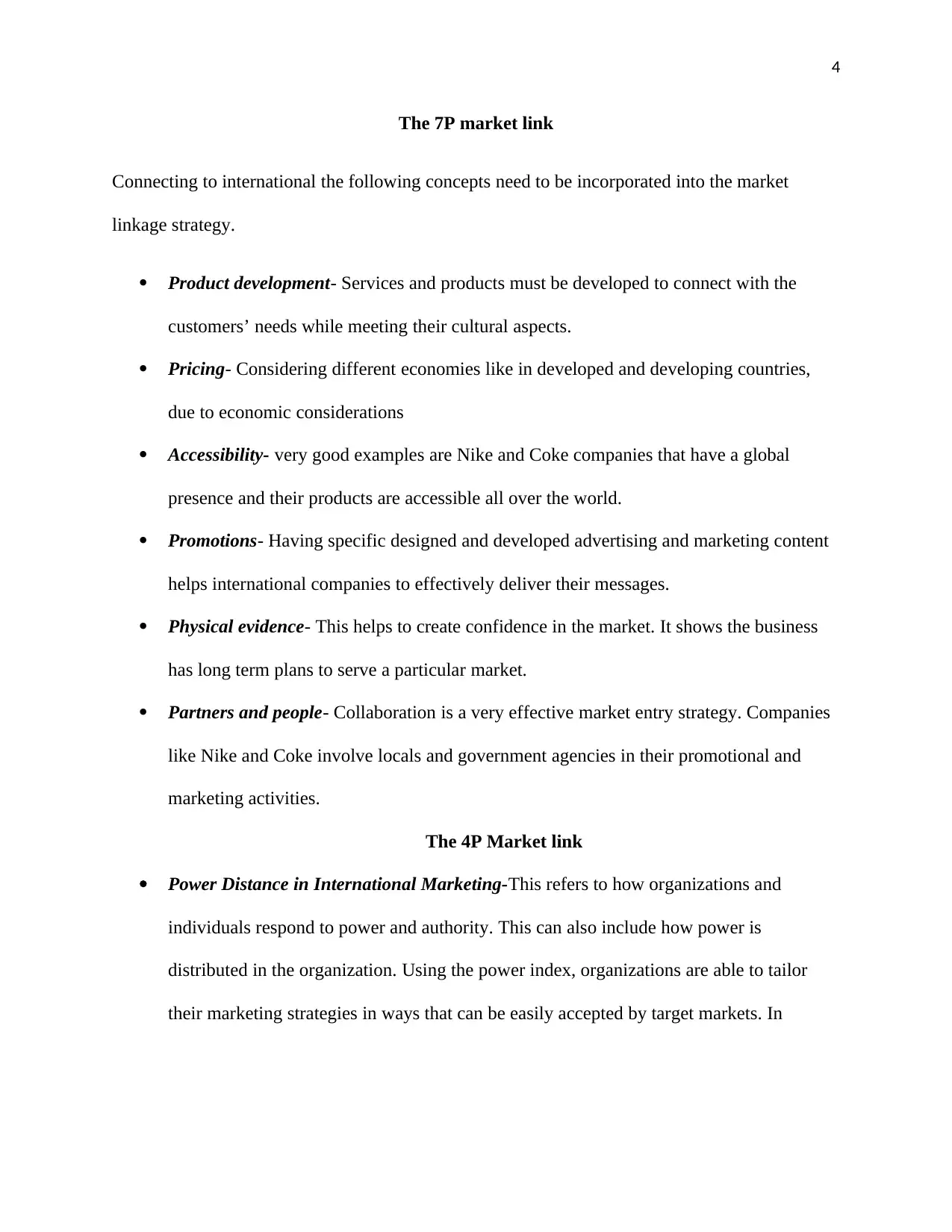
4
The 7P market link
Connecting to international the following concepts need to be incorporated into the market
linkage strategy.
Product development- Services and products must be developed to connect with the
customers’ needs while meeting their cultural aspects.
Pricing- Considering different economies like in developed and developing countries,
due to economic considerations
Accessibility- very good examples are Nike and Coke companies that have a global
presence and their products are accessible all over the world.
Promotions- Having specific designed and developed advertising and marketing content
helps international companies to effectively deliver their messages.
Physical evidence- This helps to create confidence in the market. It shows the business
has long term plans to serve a particular market.
Partners and people- Collaboration is a very effective market entry strategy. Companies
like Nike and Coke involve locals and government agencies in their promotional and
marketing activities.
The 4P Market link
Power Distance in International Marketing-This refers to how organizations and
individuals respond to power and authority. This can also include how power is
distributed in the organization. Using the power index, organizations are able to tailor
their marketing strategies in ways that can be easily accepted by target markets. In
The 7P market link
Connecting to international the following concepts need to be incorporated into the market
linkage strategy.
Product development- Services and products must be developed to connect with the
customers’ needs while meeting their cultural aspects.
Pricing- Considering different economies like in developed and developing countries,
due to economic considerations
Accessibility- very good examples are Nike and Coke companies that have a global
presence and their products are accessible all over the world.
Promotions- Having specific designed and developed advertising and marketing content
helps international companies to effectively deliver their messages.
Physical evidence- This helps to create confidence in the market. It shows the business
has long term plans to serve a particular market.
Partners and people- Collaboration is a very effective market entry strategy. Companies
like Nike and Coke involve locals and government agencies in their promotional and
marketing activities.
The 4P Market link
Power Distance in International Marketing-This refers to how organizations and
individuals respond to power and authority. This can also include how power is
distributed in the organization. Using the power index, organizations are able to tailor
their marketing strategies in ways that can be easily accepted by target markets. In
Paraphrase This Document
Need a fresh take? Get an instant paraphrase of this document with our AI Paraphraser
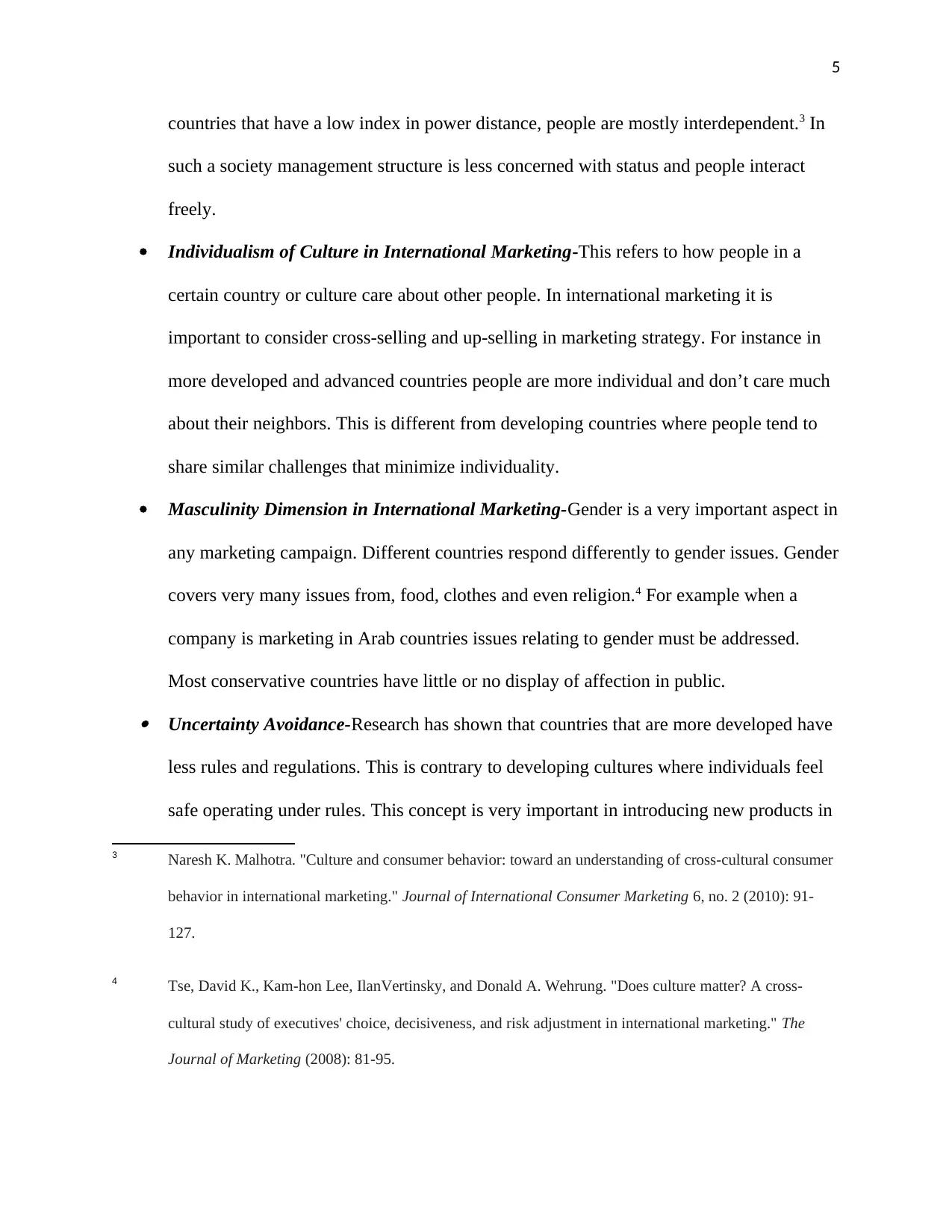
5
countries that have a low index in power distance, people are mostly interdependent.3 In
such a society management structure is less concerned with status and people interact
freely.
Individualism of Culture in International Marketing-This refers to how people in a
certain country or culture care about other people. In international marketing it is
important to consider cross-selling and up-selling in marketing strategy. For instance in
more developed and advanced countries people are more individual and don’t care much
about their neighbors. This is different from developing countries where people tend to
share similar challenges that minimize individuality.
Masculinity Dimension in International Marketing-Gender is a very important aspect in
any marketing campaign. Different countries respond differently to gender issues. Gender
covers very many issues from, food, clothes and even religion.4 For example when a
company is marketing in Arab countries issues relating to gender must be addressed.
Most conservative countries have little or no display of affection in public. Uncertainty Avoidance-Research has shown that countries that are more developed have
less rules and regulations. This is contrary to developing cultures where individuals feel
safe operating under rules. This concept is very important in introducing new products in
3 Naresh K. Malhotra. "Culture and consumer behavior: toward an understanding of cross-cultural consumer
behavior in international marketing." Journal of International Consumer Marketing 6, no. 2 (2010): 91-
127.
4 Tse, David K., Kam-hon Lee, IlanVertinsky, and Donald A. Wehrung. "Does culture matter? A cross-
cultural study of executives' choice, decisiveness, and risk adjustment in international marketing." The
Journal of Marketing (2008): 81-95.
countries that have a low index in power distance, people are mostly interdependent.3 In
such a society management structure is less concerned with status and people interact
freely.
Individualism of Culture in International Marketing-This refers to how people in a
certain country or culture care about other people. In international marketing it is
important to consider cross-selling and up-selling in marketing strategy. For instance in
more developed and advanced countries people are more individual and don’t care much
about their neighbors. This is different from developing countries where people tend to
share similar challenges that minimize individuality.
Masculinity Dimension in International Marketing-Gender is a very important aspect in
any marketing campaign. Different countries respond differently to gender issues. Gender
covers very many issues from, food, clothes and even religion.4 For example when a
company is marketing in Arab countries issues relating to gender must be addressed.
Most conservative countries have little or no display of affection in public. Uncertainty Avoidance-Research has shown that countries that are more developed have
less rules and regulations. This is contrary to developing cultures where individuals feel
safe operating under rules. This concept is very important in introducing new products in
3 Naresh K. Malhotra. "Culture and consumer behavior: toward an understanding of cross-cultural consumer
behavior in international marketing." Journal of International Consumer Marketing 6, no. 2 (2010): 91-
127.
4 Tse, David K., Kam-hon Lee, IlanVertinsky, and Donald A. Wehrung. "Does culture matter? A cross-
cultural study of executives' choice, decisiveness, and risk adjustment in international marketing." The
Journal of Marketing (2008): 81-95.
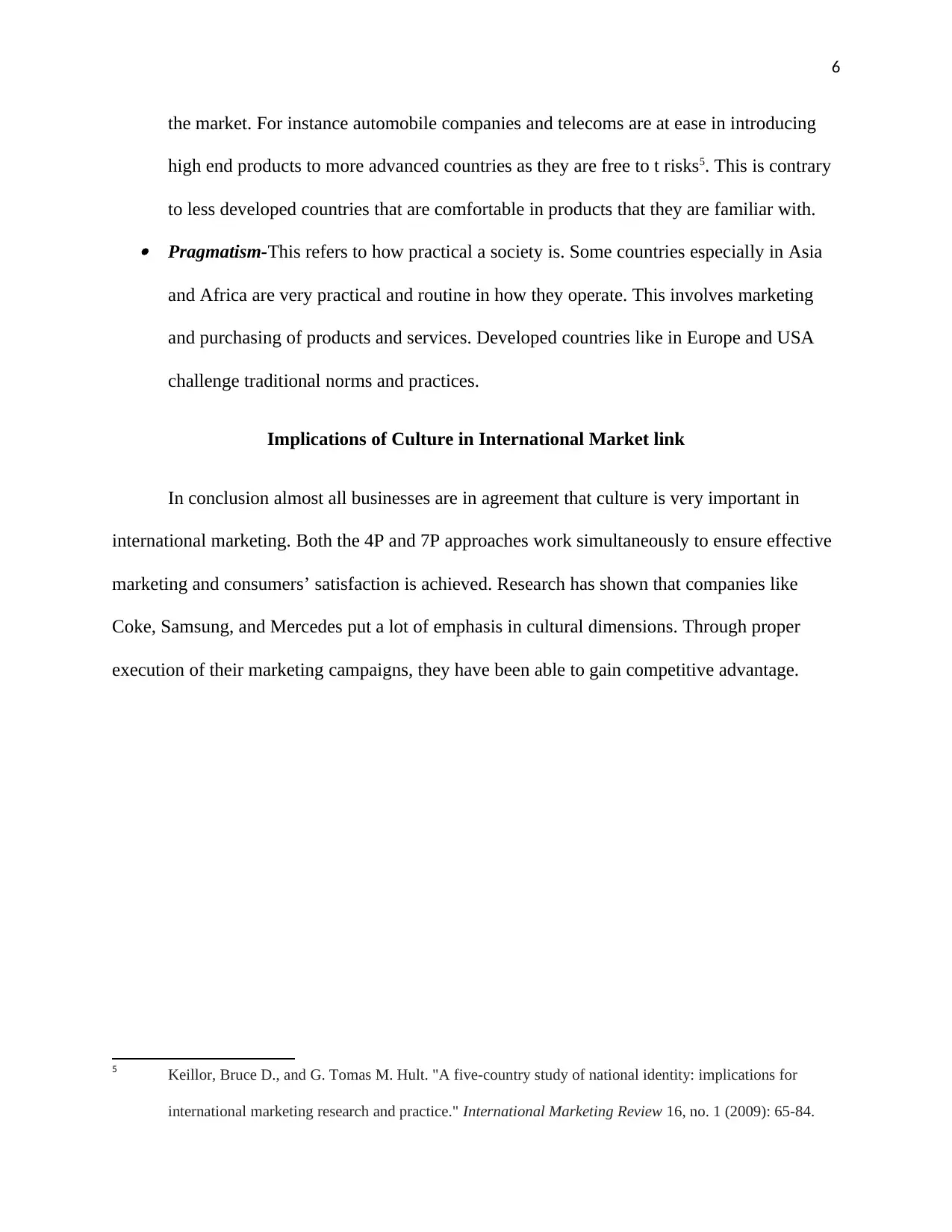
6
the market. For instance automobile companies and telecoms are at ease in introducing
high end products to more advanced countries as they are free to t risks5. This is contrary
to less developed countries that are comfortable in products that they are familiar with. Pragmatism-This refers to how practical a society is. Some countries especially in Asia
and Africa are very practical and routine in how they operate. This involves marketing
and purchasing of products and services. Developed countries like in Europe and USA
challenge traditional norms and practices.
Implications of Culture in International Market link
In conclusion almost all businesses are in agreement that culture is very important in
international marketing. Both the 4P and 7P approaches work simultaneously to ensure effective
marketing and consumers’ satisfaction is achieved. Research has shown that companies like
Coke, Samsung, and Mercedes put a lot of emphasis in cultural dimensions. Through proper
execution of their marketing campaigns, they have been able to gain competitive advantage.
5 Keillor, Bruce D., and G. Tomas M. Hult. "A five-country study of national identity: implications for
international marketing research and practice." International Marketing Review 16, no. 1 (2009): 65-84.
the market. For instance automobile companies and telecoms are at ease in introducing
high end products to more advanced countries as they are free to t risks5. This is contrary
to less developed countries that are comfortable in products that they are familiar with. Pragmatism-This refers to how practical a society is. Some countries especially in Asia
and Africa are very practical and routine in how they operate. This involves marketing
and purchasing of products and services. Developed countries like in Europe and USA
challenge traditional norms and practices.
Implications of Culture in International Market link
In conclusion almost all businesses are in agreement that culture is very important in
international marketing. Both the 4P and 7P approaches work simultaneously to ensure effective
marketing and consumers’ satisfaction is achieved. Research has shown that companies like
Coke, Samsung, and Mercedes put a lot of emphasis in cultural dimensions. Through proper
execution of their marketing campaigns, they have been able to gain competitive advantage.
5 Keillor, Bruce D., and G. Tomas M. Hult. "A five-country study of national identity: implications for
international marketing research and practice." International Marketing Review 16, no. 1 (2009): 65-84.
⊘ This is a preview!⊘
Do you want full access?
Subscribe today to unlock all pages.

Trusted by 1+ million students worldwide
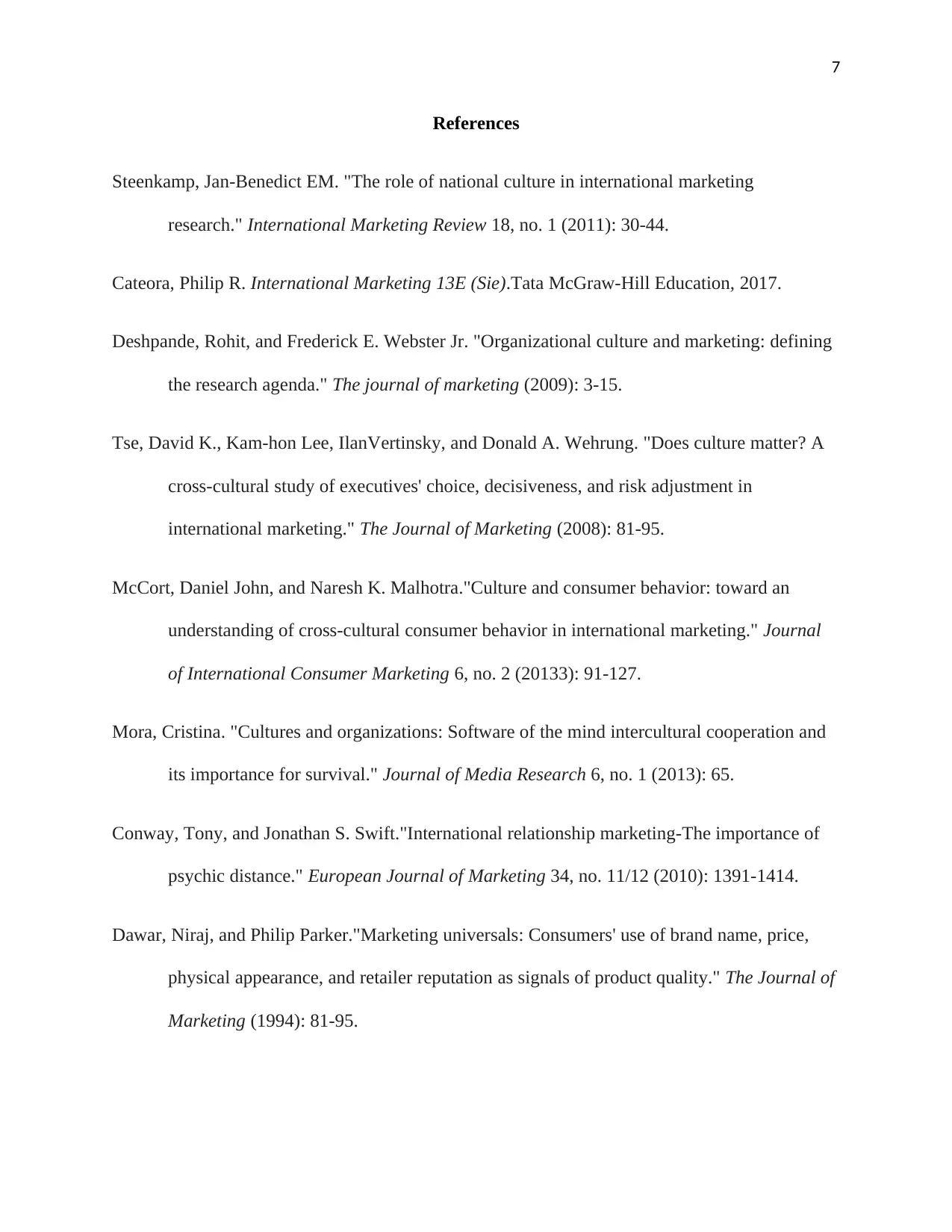
7
References
Steenkamp, Jan-Benedict EM. "The role of national culture in international marketing
research." International Marketing Review 18, no. 1 (2011): 30-44.
Cateora, Philip R. International Marketing 13E (Sie).Tata McGraw-Hill Education, 2017.
Deshpande, Rohit, and Frederick E. Webster Jr. "Organizational culture and marketing: defining
the research agenda." The journal of marketing (2009): 3-15.
Tse, David K., Kam-hon Lee, IlanVertinsky, and Donald A. Wehrung. "Does culture matter? A
cross-cultural study of executives' choice, decisiveness, and risk adjustment in
international marketing." The Journal of Marketing (2008): 81-95.
McCort, Daniel John, and Naresh K. Malhotra."Culture and consumer behavior: toward an
understanding of cross-cultural consumer behavior in international marketing." Journal
of International Consumer Marketing 6, no. 2 (20133): 91-127.
Mora, Cristina. "Cultures and organizations: Software of the mind intercultural cooperation and
its importance for survival." Journal of Media Research 6, no. 1 (2013): 65.
Conway, Tony, and Jonathan S. Swift."International relationship marketing-The importance of
psychic distance." European Journal of Marketing 34, no. 11/12 (2010): 1391-1414.
Dawar, Niraj, and Philip Parker."Marketing universals: Consumers' use of brand name, price,
physical appearance, and retailer reputation as signals of product quality." The Journal of
Marketing (1994): 81-95.
References
Steenkamp, Jan-Benedict EM. "The role of national culture in international marketing
research." International Marketing Review 18, no. 1 (2011): 30-44.
Cateora, Philip R. International Marketing 13E (Sie).Tata McGraw-Hill Education, 2017.
Deshpande, Rohit, and Frederick E. Webster Jr. "Organizational culture and marketing: defining
the research agenda." The journal of marketing (2009): 3-15.
Tse, David K., Kam-hon Lee, IlanVertinsky, and Donald A. Wehrung. "Does culture matter? A
cross-cultural study of executives' choice, decisiveness, and risk adjustment in
international marketing." The Journal of Marketing (2008): 81-95.
McCort, Daniel John, and Naresh K. Malhotra."Culture and consumer behavior: toward an
understanding of cross-cultural consumer behavior in international marketing." Journal
of International Consumer Marketing 6, no. 2 (20133): 91-127.
Mora, Cristina. "Cultures and organizations: Software of the mind intercultural cooperation and
its importance for survival." Journal of Media Research 6, no. 1 (2013): 65.
Conway, Tony, and Jonathan S. Swift."International relationship marketing-The importance of
psychic distance." European Journal of Marketing 34, no. 11/12 (2010): 1391-1414.
Dawar, Niraj, and Philip Parker."Marketing universals: Consumers' use of brand name, price,
physical appearance, and retailer reputation as signals of product quality." The Journal of
Marketing (1994): 81-95.
Paraphrase This Document
Need a fresh take? Get an instant paraphrase of this document with our AI Paraphraser
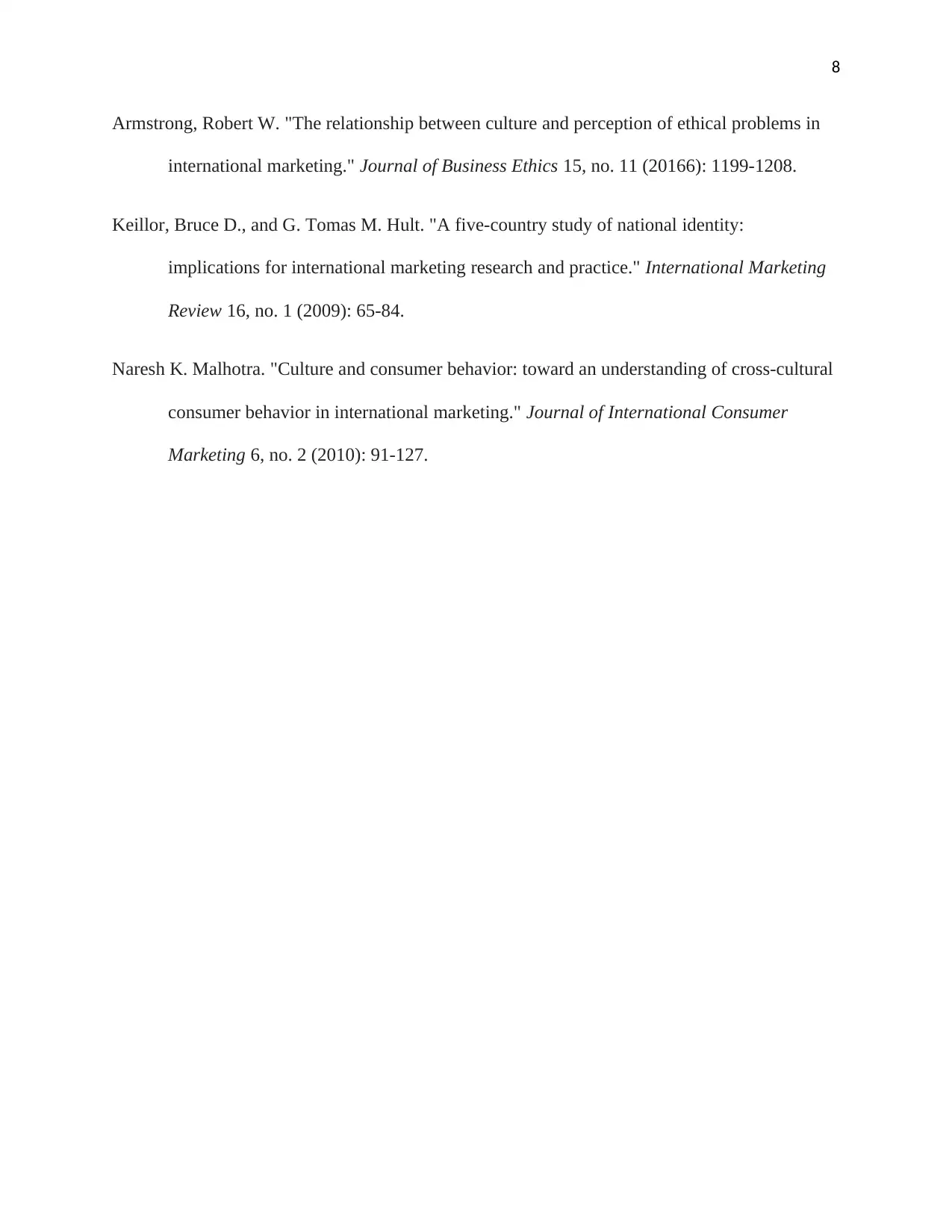
8
Armstrong, Robert W. "The relationship between culture and perception of ethical problems in
international marketing." Journal of Business Ethics 15, no. 11 (20166): 1199-1208.
Keillor, Bruce D., and G. Tomas M. Hult. "A five-country study of national identity:
implications for international marketing research and practice." International Marketing
Review 16, no. 1 (2009): 65-84.
Naresh K. Malhotra. "Culture and consumer behavior: toward an understanding of cross-cultural
consumer behavior in international marketing." Journal of International Consumer
Marketing 6, no. 2 (2010): 91-127.
Armstrong, Robert W. "The relationship between culture and perception of ethical problems in
international marketing." Journal of Business Ethics 15, no. 11 (20166): 1199-1208.
Keillor, Bruce D., and G. Tomas M. Hult. "A five-country study of national identity:
implications for international marketing research and practice." International Marketing
Review 16, no. 1 (2009): 65-84.
Naresh K. Malhotra. "Culture and consumer behavior: toward an understanding of cross-cultural
consumer behavior in international marketing." Journal of International Consumer
Marketing 6, no. 2 (2010): 91-127.
1 out of 8
Related Documents
Your All-in-One AI-Powered Toolkit for Academic Success.
+13062052269
info@desklib.com
Available 24*7 on WhatsApp / Email
![[object Object]](/_next/static/media/star-bottom.7253800d.svg)
Unlock your academic potential
Copyright © 2020–2025 A2Z Services. All Rights Reserved. Developed and managed by ZUCOL.





